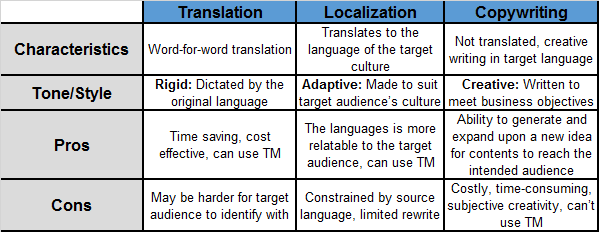What are the differences between translation, localization and copywriting

When attempting to convey your company’s marketing materials to a foreign reader, there are several ways to express your thoughts, but what is the best way – for you?Technically, we all know what translation is, but do you know the difference between translation and localization? And what about copywriting? These terms sound vastly similar, but the processes involved are in fact different.
This article will guide you through these differences, including advantages and disadvantages, to facilitate you in making a more informed decision pertaining to your global business needs.
Translation
Translation is the process of literally interpreting the content of the source language into a target language while strictly adhering to the content, the tone, and the style of the source language. It rarely makes adjustments to fit the cultural context of the target language. In other words, the content stays exactly the same. A classic example of literal translation would be “ants climbing a tree”, a direct, straightforward English translation of the classic Chinese dish “螞蟻上樹(ma-yi-shang-su)”. This might seem off-putting and bizarre for the native English speakers who have little knowledge about Chinese cuisines, and thus, might prove to be a barrier for a food-related business or a restaurant hoping to expand to English-speaking markets.
While translation may be the most efficient,and least expensive of the three, if the context and culture of the source language and its target language vastly diverge from one another, it may come across as stiff and awkward. The writing may seem too foreign for the readers and thus hard to follow, rendering your message less persuasive. Within experienced translators, a company’s brand could suffer. To avoid negative impacts, you could construct translation memory (TM) – key terms or phrases that you wish to be translated into a certain way – to enhance the consistency and accuracy of the translations, and to collaborate with competent translation service providers.
Localization
Localization conforms to the target language, making the finished product culturally appropriate for the audience. Rather than rigid word-for-word translations, localization takes the culture of the target language into account, and while the meaning remains much the same, examples and images may be changed to fit local expectations. For instance, in a culturally-appropriate McDonald’s advertisement in a Muslim country, pork would be taken off the menu. Continuing the example of “ants climbing a tree,” a more appropriate, localized version of the Chinese dish would be “spicy glass noodles with ground pork”.
Advantages of localization over translation include that it is a decent compromise between literal translation and complete copywriting; it is a smaller investment in time and money compared to copywriting, and it does not deviate from the meaning of your intended message, while adding more “familiarity” for the readers, allowing for greater resonance. Constructing a TM will also greatly enhance the quality of the output. On the other hand, it may still be constrained by the effectiveness and quality of the original language provided, as localization does not call for a complete rewrite.
Copywriting
Copywriting, or transcreation, is the process of re-creating the source language in a much more creative fashion.This is much less restrained, with the content and the flow of the work open to writer interpretation. For global marketing campaigns, this is usually the most effective, as the writer can exert much creativity and truly convey your brand/corporate message, unrestrained to the context of the source language. In fact, different content could be developed to meet your business objectives, and the language is developed in the local language rather than translated, allowing maximum reach to the target audience.
Copywriting may be expensive since prolonged discussion process can be time-consuming. It requires creative talents and you are mostly at the liberty of the writer’s subjectivity which could potentially lower the overall consistency of your global branding. In addition, your original message may be modified or changed altogether for the purpose of the business objective. Alternatively, the key advantages of copywriting are that it minimizes the risk of translation errors, the writing is more appealing and relatable to the local audience. This is extremely crucial in branding and the most attractive way to convey your business to your intended market.

















